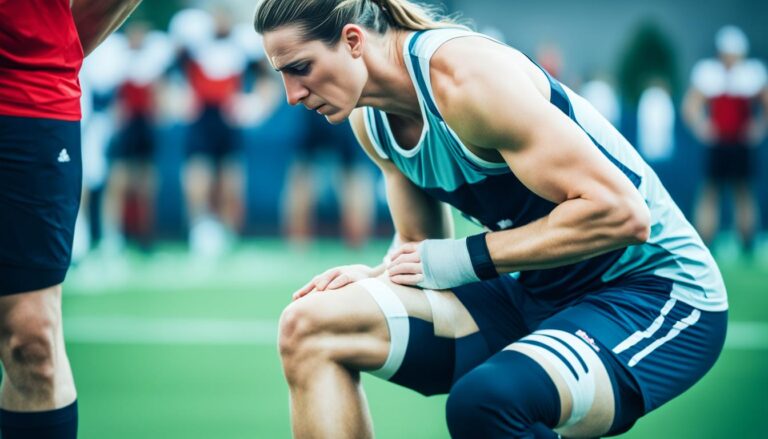Soothing Sore Knees After Running Tips
Are you experiencing sore knees after running? Don’t worry, you’re not alone. Runner’s knee, also known as patellofemoral pain syndrome, is a common injury that affects many runners. It is characterized by pain in the front of the knee and can be caused by various factors such as weak core and hip muscles, improper running form, or overuse.
At Our Running Hub, we understand the importance of maintaining healthy knees for an enjoyable running experience. In this article, we will provide you with valuable tips and solutions to help soothe your sore knees after running, prevent future knee pain, and keep you on the track to your running goals.
Key Takeaways:
- Runner’s knee, or patellofemoral pain syndrome, is a common injury among runners resulting in pain in the front of the knee.
- Stretch and strengthen the muscles around the knees to prevent knee pain.
- Proper footwear, rest, and ice application are effective in reducing knee soreness after running.
- Listen to your body and seek medical attention if the pain persists or worsens.
- >> Incorporate other forms of cardio exercise into your routine and stay hydrated to prevent knee pain.
Stretching and Strengthening Exercises for Knee Pain Relief
Stretching the muscles around the knees before running is crucial to prevent knee pain. By incorporating targeted stretches into your routine, you can alleviate soreness and improve flexibility. Focus on stretching the quadriceps, hamstrings, and calves, as these muscles are often tight and prone to injury.
The Quadriceps Stretch
The quadriceps stretch targets the front of the thigh and helps relieve tension in the knee joint. To perform this stretch, follow these steps:
- Stand upright and bring your right heel towards your buttocks by bending your knee.
- Hold your right ankle with your right hand and gently pull it towards your buttocks until you feel a stretch in the front of your thigh.
- Hold the stretch for 30 seconds and then release.
- Repeat on the left leg.
The Hamstring Stretch
The hamstring stretch targets the muscles at the back of the thigh and can help relieve tension in the knee. To perform this stretch:
- Sit on the edge of a chair with your right leg extended in front of you.
- Keeping your back straight, slowly lean forward from your hips until you feel a gentle stretch in the back of your thigh.
- Hold the stretch for 30 seconds and then release.
- Repeat on the left leg.
The Calf Stretch
The calf stretch targets the muscles in the lower leg and can help alleviate pressure on the knees. To perform this stretch:
- Stand facing a wall and place your hands on the wall for support.
- Take a step back with your right leg, keeping your heel on the ground.
- Bend your left leg forward and lean towards the wall, feeling a stretch in your right calf.
- Hold the stretch for 30 seconds and then release.
- Repeat on the other leg.
In addition to stretching, strengthening exercises are important for knee pain relief. Building strength in the leg muscles and core helps support the knees and improve stability. Incorporate exercises like squats, lunges, and plyometric training into your workout routine.
“Building strength in the leg muscles and core helps support the knees and improve stability.”
Remember to perform these exercises regularly and with proper form to ensure the muscles are able to support the knees during running. If you experience any pain or discomfort while performing these exercises, it is important to consult with a healthcare professional for guidance.
Preventive Measures for Knee Pain After Running
To avoid knee pain while running, it is essential to take preventive measures. By following these guidelines, you can minimize the risk of injury and maximize your running experience.
1. Wear Proper Footwear
Choosing the right footwear is crucial when it comes to preventing knee pain during running. Ensure that your shoes provide adequate support and fit well. This will help maintain proper alignment of your feet and legs, reducing stress on your knees.
2. Stretch Before and After Running
Stretching is an integral part of any running routine. Before you start running, make sure to stretch your muscles properly. Focus on stretching the quadriceps, hamstrings, and calves, as these muscles play a significant role in knee stability. After your run, take a few moments to stretch again, helping to reduce muscle tightness and improve flexibility.
3. Listen to Your Body
Pay attention to the signals your body sends you during and after running. If you start experiencing discomfort or pain in your knees, it is essential to know when to rest and take a break. Pushing through the pain can worsen the condition and lead to more significant problems. Resting and allowing your body to recover is crucial in preventing knee pain from recurring.
4. Differentiate Between Injury and Muscle Soreness
It is essential to be aware of the difference between normal muscle soreness and an injury. Muscle soreness is a common occurrence after intense exercise and can be alleviated with rest and proper recovery. However, if the pain persists or intensifies, it may indicate an injury that requires medical attention. Consult a healthcare professional to assess your condition and receive appropriate treatment.

By implementing these preventive measures, you can significantly reduce the risk of knee pain during running. Wearing proper footwear, stretching appropriately, listening to your body, and being aware of the difference between muscle soreness and injury are all essential in maintaining the health of your knees. By taking care of your knees, you can continue to enjoy the benefits and joy of running without having to worry about knee pain.
Treatment Options for Runner’s Knee
When it comes to treating runner’s knee, there are several options available that can help alleviate pain and promote healing. For most people, conservative methods are effective in managing this common knee injury from running.
“Resting the knee and avoiding activities that exacerbate the pain is important for the healing process.”
Resting the knee allows the inflamed tissues to recover and reduces the risk of further damage. It is essential to avoid activities that worsen the pain, such as running on hard surfaces or engaging in high-impact exercises.
Applying ice to the affected area can help reduce swelling and alleviate pain. Ice should be applied for 15-20 minutes at a time, multiple times throughout the day. Using compression techniques, such as wearing a knee brace or wrap, can also provide support to the injured knee and reduce discomfort.
Over-the-counter nonsteroidal anti-inflammatory drugs (NSAIDs) can be used to manage pain and inflammation associated with runner’s knee. These medications, such as ibuprofen or naproxen, can provide temporary relief and aid in the healing process.
“Stretching and strengthening exercises, particularly those targeting the quadriceps muscles, can also help alleviate knee pain.”
Stretching exercises focused on the muscles around the knee, such as the quadriceps, hamstrings, and calves, can help improve flexibility and reduce tension in the knee joint. Strengthening exercises, such as squats, lunges, and leg presses, can help build strong muscles that support the knee during running.
In severe cases where conservative treatments fail to provide relief, surgery may be necessary. Surgical interventions for runner’s knee can include repairing damaged cartilage, realigning the kneecap, or addressing other underlying issues contributing to the knee pain.
Comparing Treatment Options for Runner’s Knee
| Treatment Option | Description | Effectiveness | Risks |
|---|---|---|---|
| Rest and Activity Modification | Resting the knee and avoiding aggravating activities | Effective in promoting healing | None |
| Ice and Compression | Applying ice and using compression techniques to reduce swelling | Provides temporary pain relief and reduces inflammation | None |
| Over-the-counter NSAIDs | Taking nonsteroidal anti-inflammatory drugs to manage pain and inflammation | Effective in pain management | Potential side effects |
| Stretching and Strengthening Exercises | Performing exercises to improve flexibility and strengthen the muscles around the knee | Helps alleviate knee pain and prevent future injuries | May aggravate symptoms if performed incorrectly |
| Surgery | Invasive procedures to address underlying issues or repair damaged tissues | Considered when conservative treatments fail | Risks associated with surgery |
Note: It is important to consult with a healthcare professional for an accurate diagnosis and personalized treatment plan tailored to your specific condition.
By utilizing these treatment options and taking a comprehensive approach to managing runner’s knee, individuals can find relief and get back to their running routine with reduced knee pain.
Conclusion
Sore knees after running can be a common issue, but with proper preventive measures and treatment options, it is possible to find relief. By incorporating stretching, strengthening exercises, and wearing proper footwear into our running routine, we can effectively prevent knee pain. Stretching the muscles around the knees before and after a run helps maintain flexibility and reduce the risk of injury. Additionally, engaging in regular exercises that target the leg muscles and core can provide the necessary support to protect our knees during running.
Resting, applying ice, and using over-the-counter medications are effective ways to alleviate soreness and inflammation in the knees. These simple remedies can help reduce pain and discomfort after a run. However, it is important to listen to our bodies and seek medical attention if the pain persists or worsens. Consulting with a healthcare professional can provide valuable insights and guidance on proper treatment options.
By taking these preventive measures and paying attention to our bodies, we can continue to enjoy running while minimizing the risk of knee pain. Prevention is key when it comes to maintaining healthy knees, and by following these guidelines, we can ensure that sore knees after running become a thing of the past.
FAQ
Is knee pain common after running?
Yes, knee pain after running is a common issue among runners.
What is runner’s knee?
Runner’s knee, also known as patellofemoral pain syndrome, is characterized by pain in the front of the knee and is often caused by weakness in the core and hips.
How can I prevent runner’s knee?
To prevent runner’s knee, it is important to stretch the muscles around the knees before running, strengthen the leg muscles and core, and incorporate other forms of cardio into your routine. Additionally, staying hydrated is crucial.
What exercises can help alleviate knee pain from running?
Stretching the quadriceps, hamstrings, and calves, as well as performing exercises like squats, lunges, and plyometric training can help alleviate knee pain and strengthen the muscles supporting the knees.
What are some preventive measures for knee pain during running?
Wearing proper footwear, stretching properly before and after a run, listening to your body, and knowing when to rest are important preventive measures for knee pain during running.
How can runner’s knee be treated?
Resting the knee, applying ice, using compression techniques, and taking over-the-counter NSAIDs can help treat runner’s knee. Stretching and strengthening exercises, and in severe cases, surgery, are also treatment options.
What can I do to soothe sore knees after running?
Stretching, wearing proper footwear, resting, applying ice, and using over-the-counter medications can help soothe sore knees after running.






